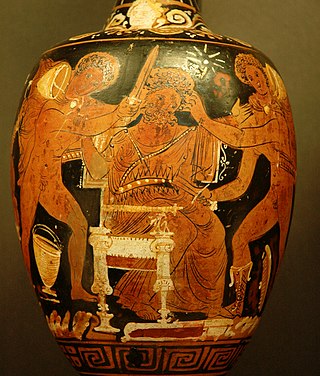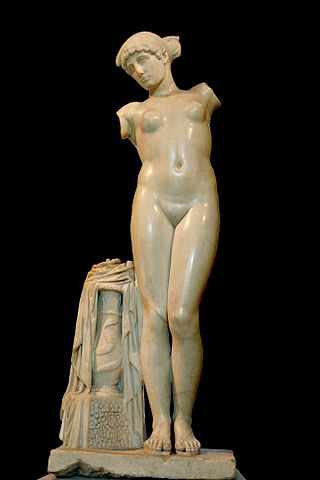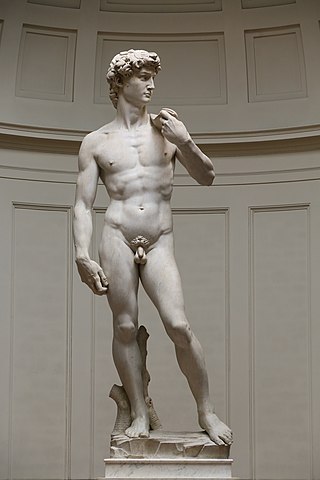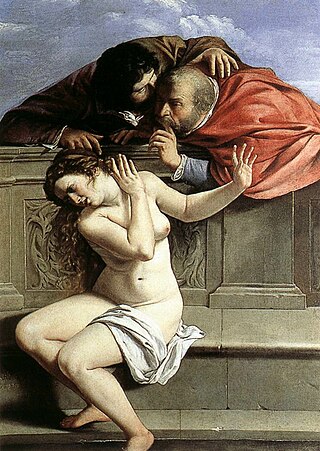
Orestes and Electra has been the subject and title of several works of art, including two different sculptural groups in the collections of the Naples National Archaeological Museum.

Orestes and Electra has been the subject and title of several works of art, including two different sculptural groups in the collections of the Naples National Archaeological Museum.
One is a 2.1m high Hellenistic sculpture, once thought to depict Orestes and Electra. It shows a heavily draped adult female on the right, looking down on and apparently beckoning a partially nude younger male or child, who looks up at her.
A marble copy was produced between 1685 and 1688 for the Palace of Versailles, copied from a cast of the original entrusted to Benoît Massou then Martin Carlier and to Michel Monier. It was initially interpreted as Peace between the Greeks and the Roman but was later interpreted as relating the episode in which the young Papirius, known as Praetextatus, having been permitted to attend a sitting of the Roman Senate with his father, thwarts his mother's curiosity by humorously telling her that the Senate had been debating whether it were better for the State that a man have two wives or a woman have two husbands. It was placed in the Ballroom Grove in 1738, moved to the Tuileries Garden during the French Revolution and in the 19th century replaced Poetus and Arria on the Green Carpet in the Main Perspective. [1]

The other depicts a young nude male and a young clothed female, of the same age and height, leaning on each other. [2] This is now thought to be Orestes and Electra.

Aegisthus was a figure in Greek mythology. Aegisthus is known from two primary sources: the first is Homer's Odyssey, believed to have been first written down by Homer at the end of the 8th century BC, and the second from Aeschylus's Oresteia, written in the 5th century BC. Aegisthus also features heavily in the action of Euripides's Electra, although his character remains offstage.

In Greek mythology, Orestes or Orestis was the son of Clytemnestra and Agamemnon, and the brother of Electra. He is the subject of several Ancient Greek plays and of various myths connected with his madness and purification, which retain obscure threads of much older ones.

Electra, also spelt Elektra, is one of the most popular mythological characters in tragedies. She is the main character in two Greek tragedies, Electra by Sophocles and Electra by Euripides. She is also the central figure in plays by Aeschylus, Alfieri, Voltaire, Hofmannsthal, and Eugene O'Neill. She is a vengeful soul in The Libation Bearers, the second play of Aeschylus' Oresteia trilogy. She plans out an attack with her brother to kill their mother, Clytemnestra.

In Greek mythology, Pylades was a Phocian prince as the son of King Strophius and Anaxibia who is the daughter of Atreus and sister of Agamemnon and Menelaus. He is mostly known for his relationship with his cousin Orestes, son of Agamemnon.

Erotic art is a broad field of the visual arts that includes any artistic work intended to evoke arousal. It usually depicts human nudity or sexual activity, and has included works in various visual mediums, including drawings, engravings, films, paintings, photographs, and sculptures. Some of the earliest known works of art include erotic themes, which have recurred with varying prominence in different societies throughout history. However, it has also been widely considered taboo, with either social norms or laws restricting its creation, distribution, and possession. This is particularly the case when it is deemed pornographic, immoral, or obscene.

Electra, also Elektra or The Electra, is a Greek tragedy by Sophocles. Its date is not known, but various stylistic similarities with the Philoctetes and the Oedipus at Colonus lead scholars to suppose that it was written towards the end of Sophocles' career. Jebb dates it between 420 BC and 414 BC.

Euripides' Electra is a play probably written in the mid 410s BC, likely before 413 BC. It is unclear whether it was first produced before or after Sophocles' version of the Electra story.

Le Déjeuner sur l'herbe – originally titled Le Bain – is a large oil on canvas painting by Édouard Manet created in 1862 and 1863.

I Modi, also known as The Sixteen Pleasures or under the Latin title De omnibus Veneris Schematibus, is a famous erotic book of the Italian Renaissance that had engravings of sexual scenes. The engravings were created in a collaboration between Giulio Romano and Marcantonio Raimondi. They were thought to have been created around 1524 to 1527.

The Dying Gaul, also called The Dying Galatian or The Dying Gladiator, is an ancient Roman marble semi-recumbent statue now in the Capitoline Museums in Rome. It is a copy of a now lost Greek sculpture from the Hellenistic period thought to have been made in bronze. The original may have been commissioned at some time between 230 and 220 BC by Attalus I of Pergamon to celebrate his victory over the Galatians, the Celtic or Gaulish people of parts of Anatolia. The original sculptor is believed to have been Epigonus, a court sculptor of the Attalid dynasty of Pergamon.
The Flies is a play by Jean-Paul Sartre, produced in 1943. It is an adaptation of the Electra myth, previously used by the Greek playwrights Sophocles, Aeschylus and Euripides. The play recounts the story of Orestes and his sister Electra in their quest to avenge the death of their father Agamemnon, king of Argos, by killing their mother Clytemnestra and her husband Aegisthus, who had deposed and killed him.

Iphigenia in Tauris is a reworking by Johann Wolfgang von Goethe of the ancient Greek tragedy Ἰφιγένεια ἐν Ταύροις by Euripides. Euripides' title means "Iphigenia among the Taurians", whereas Goethe's title means "Iphigenia in Taurica", the country of the Tauri.

Orestes (408 BCE) is an Ancient Greek play by Euripides that follows the events of Orestes after he had murdered his mother.

The Aphrodite of Knidos was an Ancient Greek sculpture of the goddess Aphrodite created by Praxiteles of Athens around the 4th century BC. It was one of the first life-sized representations of the nude female form in Greek history, displaying an alternative idea to male heroic nudity. Praxiteles' Aphrodite was shown nude, reaching for a bath towel while covering her pubis, which, in turn leaves her breasts exposed. Up until this point, Greek sculpture had been dominated by male nude figures. The original Greek sculpture is no longer in existence; however, many Roman copies survive of this influential work of art. Variants of the Venus Pudica are the Venus de' Medici and the Capitoline Venus.

The history of erotic depictions includes paintings, sculpture, photographs, dramatic arts, music and writings that show scenes of a sexual nature throughout time. They have been created by nearly every civilization, ancient and modern. Early cultures often associated the sexual act with supernatural forces and thus their religion is intertwined with such depictions. In Asian countries such as India, Nepal, Sri Lanka, Japan, Korea, and China, representations of sex and erotic art have specific spiritual meanings within native religions. The ancient Greeks and Romans produced much art and decoration of an erotic nature, much of it integrated with their religious beliefs and cultural practices.

The Esquiline Venus, depicting the goddess Venus, is a smaller-than-life-size Roman nude marble sculpture of a female in sandals and a diadem headdress. It is widely viewed as a 1st-century AD Roman copy of a Greek original from the 1st century BC. It is also a possible depiction of the Ptolemaic ruler Cleopatra VII.

The nude, as a form of visual art that focuses on the unclothed human figure, is an enduring tradition in Western art. It was a preoccupation of Ancient Greek art, and after a semi-dormant period in the Middle Ages returned to a central position with the Renaissance. Unclothed figures often also play a part in other types of art, such as history painting, including allegorical and religious art, portraiture, or the decorative arts. From prehistory to the earliest civilizations, nude female figures were generally understood to be symbols of fertility or well-being.

In neo-Freudian psychology, the Electra complex, as proposed by Swiss psychiatrist and psychoanalyst Carl Jung in his Theory of Psychoanalysis, is a girl's psychosexual competition with her mother for possession of her father. In the course of her psychosexual development, the complex is the girl's phallic stage; a boy's analogous experience is the Oedipus complex. The Electra complex occurs in the third—phallic stage —of five psychosexual development stages: the oral, the anal, the phallic, the latent, and the genital—in which the source of libido pleasure is in a different erogenous zone of the infant's body.

The Gods Are Athirst is a 1912 novel by Anatole France. It is set in Paris in 1793–1794, closely tied to specific events of the French Revolution.

Susanna and the Elders is an Old Testament story of a woman falsely accused of adultery after she refuses two men who, after discovering one another in the act of spying on her while she bathes, conspire to blackmail her for sex. Depictions of the story date back to the late 3rd/early 4th centuries and are still being created.